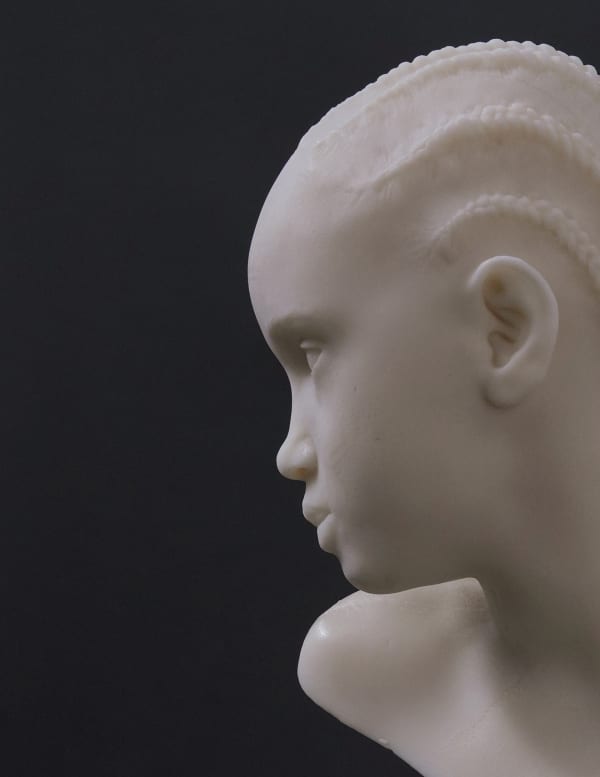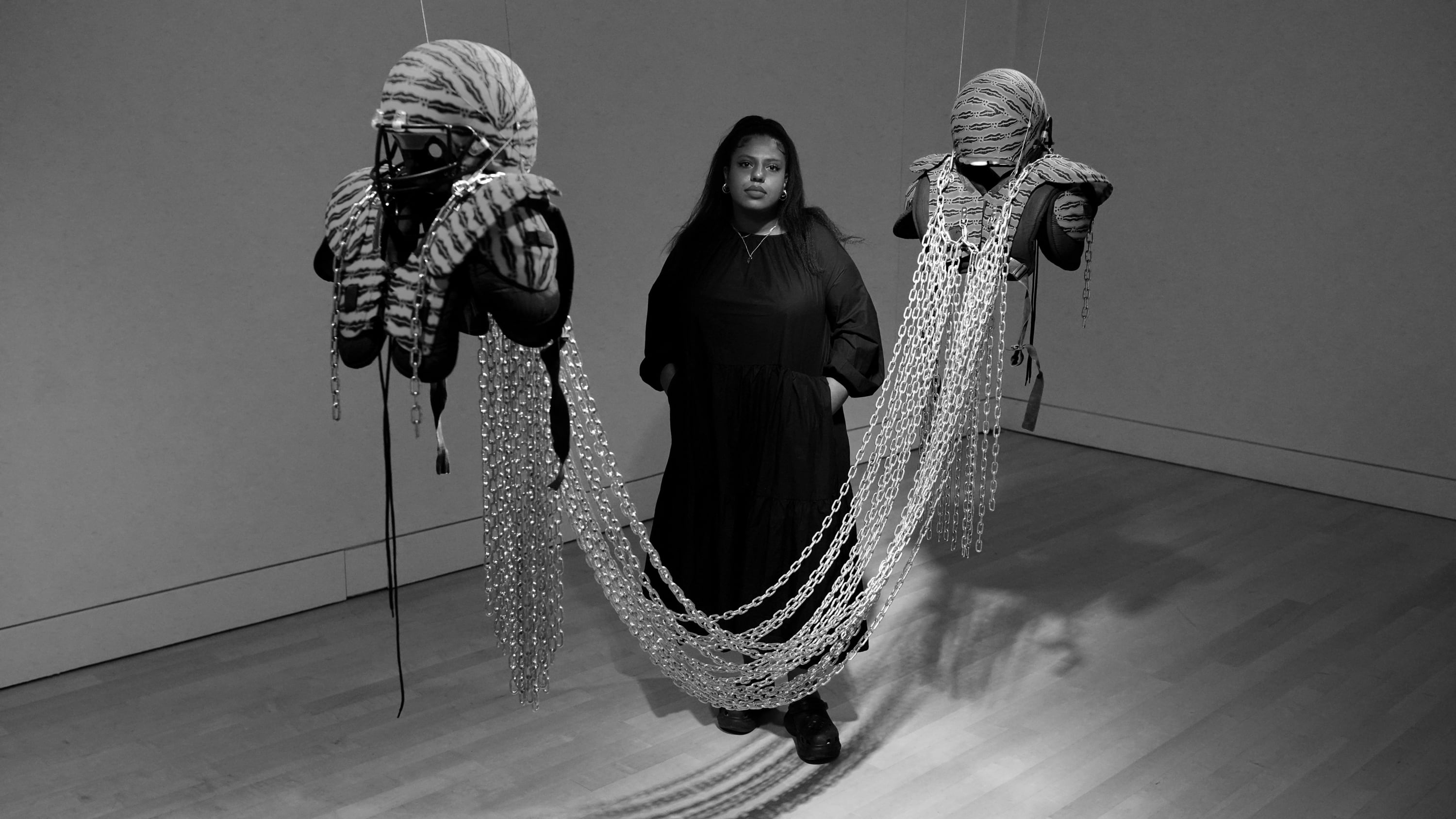-
-
“They should consume us in the light of the truth, in the light of racial injustice, in the light of the things we don’t usually want to talk about."
–Esmaa Mohamoud
-
Kavi Gupta presents Let Them Consume Me In The Light, a solo exhibition of new works by internationally acclaimed conceptual artist Esmaa Mohamoud. The exhibition examines what Mohamoud calls “Black body politics”—a web of interconnected personal, social, economic, and historical factors that shape how Blackness is perceived by Black people and nonBlack people alike. The title alludes to the inevitability that Black cultural products and their creators will be exploited by majoritarian society. “They’re already gonna consume us, it might as well be out in the open,” Mohamoud says.“They should consume us in the light of the truth, in the light of racial injustice, in the light of the things we don’t usually want to talk about. There are many lights this exhibition can hold.”Four paradoxical sculptural phenomena fill the gallery: an elegant but inaccessibly tall peacock chair; a marvelous but un-drivable pink Cadillac; an enchanting but lifeless prairie of black steel dandelions; and the visages of three young African girls, tenderly carved from shea butter. The utilitarian functionality of Mohamoud’s uncanny creations has been obliterated, leaving only their artifice to behold.
-
Like monuments to nostalgia lining a road to nirvana, they make longing and nothingness seem eerily the same. A Seat Above the Table (Angela Bassett), Mohamoud’s 12-foot-tall rattan peacock chair, is named in honor of an actress who towers over her contemporaries, deserving not only a seat at the table but a seat high above it. Black Panther leader Huey P. Newton was famously photographed sitting in such a chair during the height of the 1960s Civil Rights Era, transforming it from an ordinary piece of furniture into an icon of pride and power. With its seat raised absurdly beyond the reach of a sitter, Mohamoud’s peacock chair takes on a double meaning that infers the hollowness that often underlies symbols. Its rattan bars project penitent shadows on the walls—a reminder that the original peacock chairs were woven by prisoners in colonial Asia (particularly the Philippines) and then sold to visiting dignitaries, with the revenue channeled back into the prisons.
-
Mohamoud’s colossal pink Cadillac sculpture, titled Nirvana (Oh, Sweet Elham), perches on steel rims so massive that viewers can walk under its glossy chassis. From there, they can see that the guts of the car have been removed, rendering it useless as a conveyance. The work was initially inspired by a miniature black Cadillac VHS tape rewinder once owned by Mohamoud’s grandmother Elham. Examining her childhood memories of watching movies with her grandmother and rewinding them in that little car prompted Mohamoud to research how Cadillacs became an iconic part of Black culture. She learned how Black people were systematically barred from purchasing luxury automobiles in the early 20th century.Threatened by slumping sales as wealthy White people lost their fortunes in the Great Depression, Cadillac broke the trend, becoming the first luxury car brand in America to directly market and sell to Black consumers. Mohamoud underscores the literal emptiness of Nirvana (Oh, Sweet Elham) with symbolic custom additions. Hidden speakers broadcasting ghostly melodies through the void; an American flag vanity license plate bearing the slogan In God We Trust; and a dazzling but inoperative chrome steering wheel become tokens of the strange currencies of visibility, status, and shine. -
Like the peacock chair and Cadillac they surround, Mohamoud’s black steel dandelions are notable for both their beauty and their artificiality. Part of a larger installation project called Faith in the Seeds, the dandelions memorialize Black people killed by police violence. Dandelions are hardy wildflowers that can survive in even the harshest conditions, and are known to be among the most nutritious plants on the planet.Nonetheless, they became classified as weeds in the majority White suburbs of North America, where pristine green lawns signal a homeowner’s assiduousness and dominion over nature. In the gallery, Mohamoud’s dandelions are bathed in a soft, yellow-orange light, like a peaceful sunset. Pillows are offered to visitors who wish to sit among the dandelions.Mohamoud calls it a “melanin charging station,” a space of peace and lightness to just exist in and absorb energy before having to go back out into a world filled with racism and hate.
-
“The eradication of Black bodies by the American police is analogous with dandelions,” Mohamoud says. “Dandelions are beautiful, but people hate this flower. We have conditioned ourselves for this response. I couldn’t unsee the comparison between the resilience of dandelions and the resilience of the Black community. The African diaspora, it spreads its seeds in the wind.”
-
Titled Gluttony, Gluttony, Gluttony, Mohamoud’s shea butter triptych mobilizes a material prized as a moisturizer to shine light on the exploitation of child labor in Africa. Before carving it, Mohamoud dries her ethically sourced shea butter until it takes on an ivory color. No longer useful as a beauty product, the material is carved into the haunting reflections of the young African girls who harvest shea nuts in Africa. Sitting atop Italian marble plinths, the three busts are surrounded by 15,000 sculpted shea butter nuts, cast from real Ghanaian shea nuts. Ghana produces around 130,000 tons of shea butter per year.While the international companies that export the material make exorbitant profits, the women who harvest and process shea nuts are ruthlessly exploited, working long hours, largely during the rainy season, and typically earning the equivalent of about two dollars after a five-day work week. “It’s this system of North American consumption without regard for the environment or for the young girls who are doing the labor,” Mohamoud says. “Feels like gluttony to me.”Replacing monolithic depictions of Black culture with more layered representations, Let Them Consume Me In The Light elucidates the complexity of the narratives shaping contemporary Black body politics. Mohamoud creates space in which to reconsider our nostalgia for misremembered, and often misrepresented histories, and invites us into a more open and multitudinous relationship with Blackness than we have had in the past.
-

-
Mohamoud’s critically acclaimed solo exhibition To Play in the Face of Certain Defeat debuted at Museum London in Ontario and is currently on view at the Art Gallery of Alberta, following iterations at the Art Galleries of Ottawa, Winnipeg, and Hamilton (Ontario). Other recent exhibitions featuring Mohamoud’s work include Garmenting: Costume and Contemporary Art,Museum of Arts and Design, New York, NY, USA; In These Truths, Buffalo AKG Art Museum, Buffalo, NY, USA; and Esmaa Mohamoud: It Cannot Always Be Night, Arsenal Contemporary, New York, NY, USA; as well as exhibitions at the Royal Ontario Museum; Museum of Fine Arts Montreal; and Weatherspoon Art Museum, UNCG, Greensboro, NC, USA, among others. Works by Mohamoud are in the permanent collections of the National Gallery of Canada; Art Gallery of Ontario; Weatherspoon Museum; Institute for the Humanities, University of Michigan; Museum London; and University of Victoria Legacy Art Galleries, among others. Mohamoud was an Artist-in-Residence in Kehinde Wiley’s renowned Black Rock Senegal residency program in Dakar, Senegal in 2021.




